Tourism Industry: Sustainable and Responsible Management Practices
VerifiedAdded on 2023/06/17
|11
|2814
|355
Report
AI Summary
This report delves into the sustainable and responsible management of tourism businesses and destinations, emphasizing the importance of balancing economic development with environmental and social responsibility. It examines key concepts, theories such as the Butler Model and the Triple Bottom Line, and principles for minimizing negative impacts and maximizing benefits to local communities. The report further discusses practical applications within tourism and hospitality organizations, including protecting cultural and natural heritage, providing tangible social and economic benefits, and engaging local communities. It also appraises the contribution of tourism development and highlights best practices for businesses, such as stakeholder engagement, establishing baselines, and setting clear goals to foster sustainable growth. This document is a student contribution published on Desklib, a platform offering AI-based study tools and resources for students.
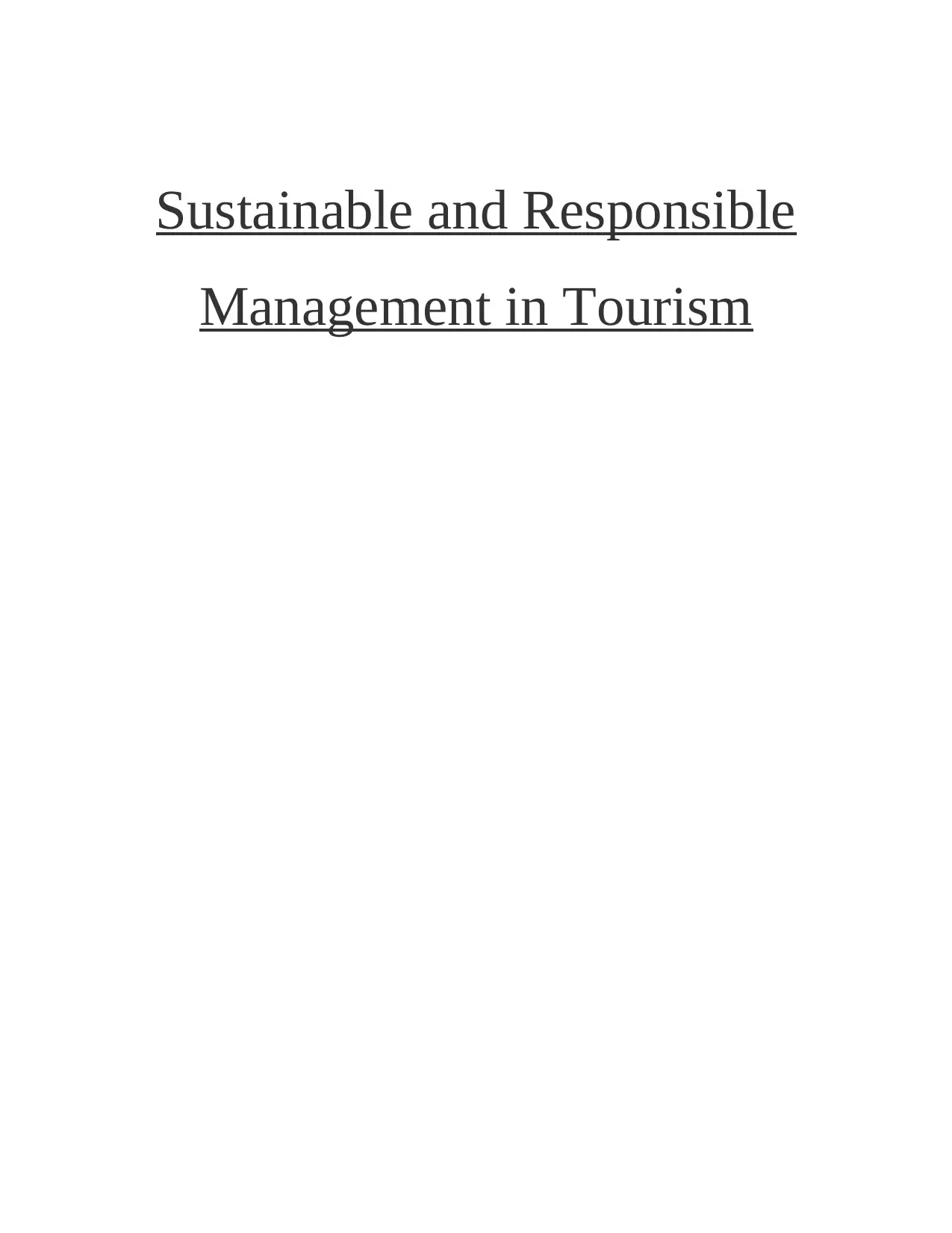
Sustainable and Responsible
Management in Tourism
Management in Tourism
Paraphrase This Document
Need a fresh take? Get an instant paraphrase of this document with our AI Paraphraser
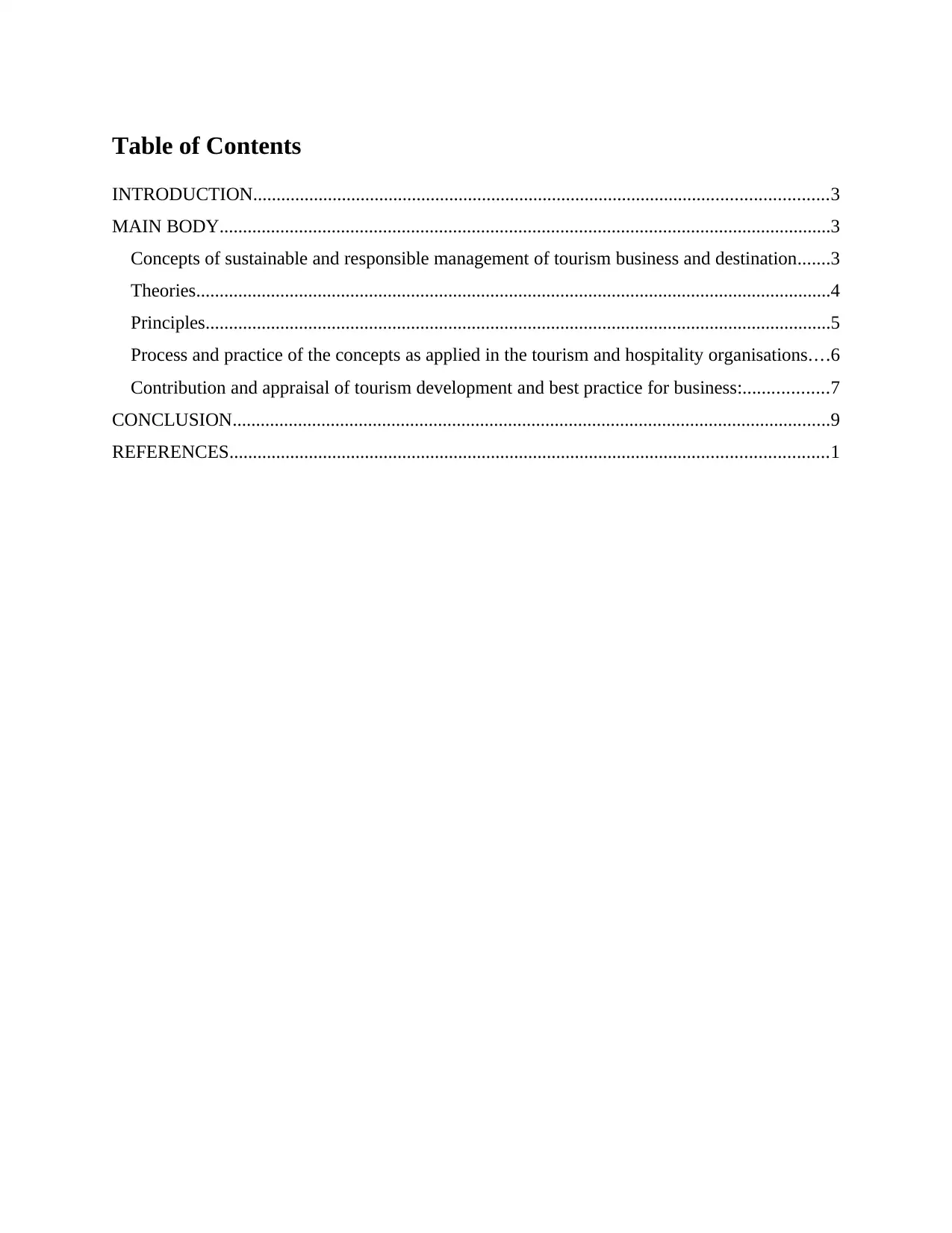
Table of Contents
INTRODUCTION...........................................................................................................................3
MAIN BODY...................................................................................................................................3
Concepts of sustainable and responsible management of tourism business and destination.......3
Theories........................................................................................................................................4
Principles......................................................................................................................................5
Process and practice of the concepts as applied in the tourism and hospitality organisations....6
Contribution and appraisal of tourism development and best practice for business:..................7
CONCLUSION................................................................................................................................9
REFERENCES................................................................................................................................1
INTRODUCTION...........................................................................................................................3
MAIN BODY...................................................................................................................................3
Concepts of sustainable and responsible management of tourism business and destination.......3
Theories........................................................................................................................................4
Principles......................................................................................................................................5
Process and practice of the concepts as applied in the tourism and hospitality organisations....6
Contribution and appraisal of tourism development and best practice for business:..................7
CONCLUSION................................................................................................................................9
REFERENCES................................................................................................................................1
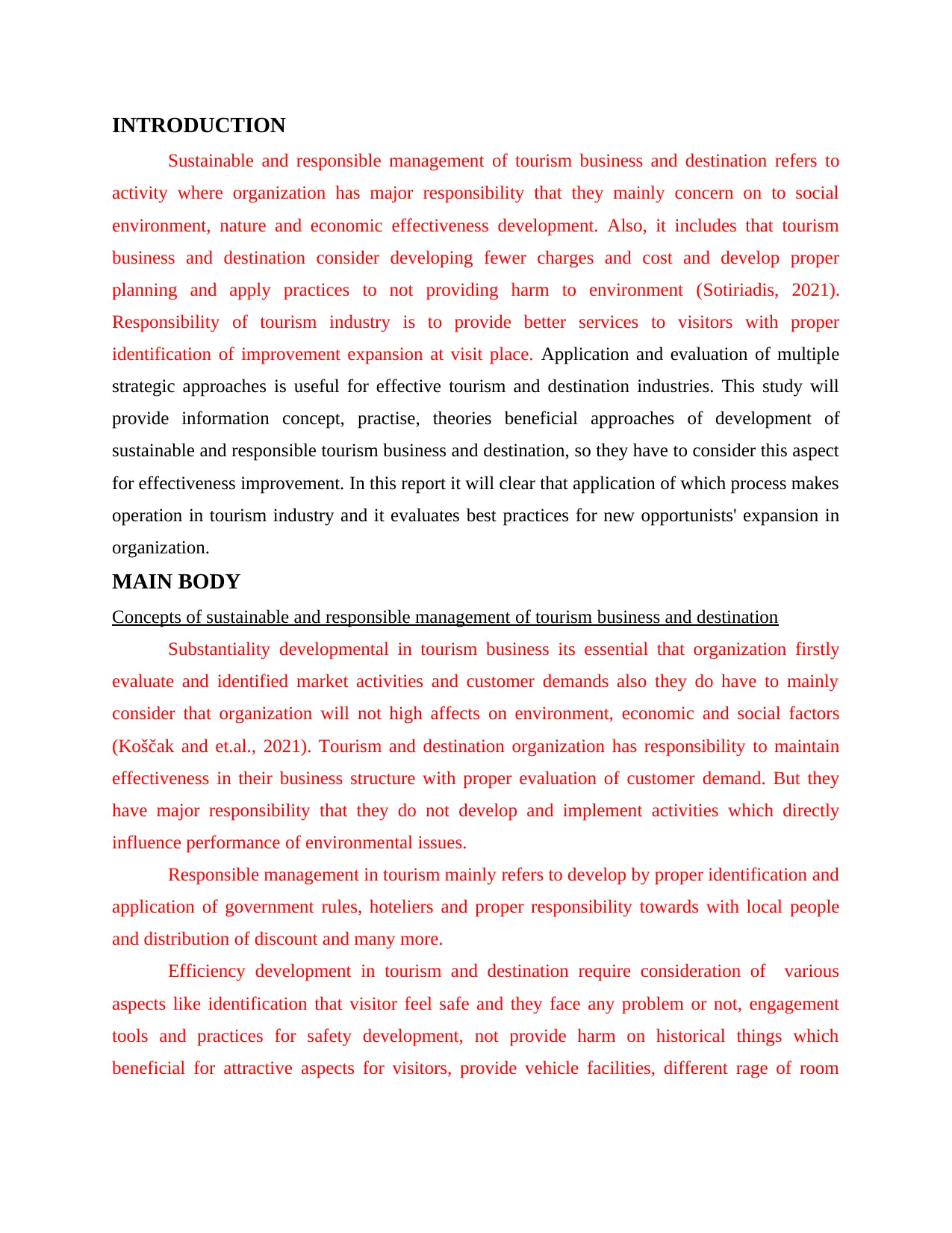
INTRODUCTION
Sustainable and responsible management of tourism business and destination refers to
activity where organization has major responsibility that they mainly concern on to social
environment, nature and economic effectiveness development. Also, it includes that tourism
business and destination consider developing fewer charges and cost and develop proper
planning and apply practices to not providing harm to environment (Sotiriadis, 2021).
Responsibility of tourism industry is to provide better services to visitors with proper
identification of improvement expansion at visit place. Application and evaluation of multiple
strategic approaches is useful for effective tourism and destination industries. This study will
provide information concept, practise, theories beneficial approaches of development of
sustainable and responsible tourism business and destination, so they have to consider this aspect
for effectiveness improvement. In this report it will clear that application of which process makes
operation in tourism industry and it evaluates best practices for new opportunists' expansion in
organization.
MAIN BODY
Concepts of sustainable and responsible management of tourism business and destination
Substantiality developmental in tourism business its essential that organization firstly
evaluate and identified market activities and customer demands also they do have to mainly
consider that organization will not high affects on environment, economic and social factors
(Koščak and et.al., 2021). Tourism and destination organization has responsibility to maintain
effectiveness in their business structure with proper evaluation of customer demand. But they
have major responsibility that they do not develop and implement activities which directly
influence performance of environmental issues.
Responsible management in tourism mainly refers to develop by proper identification and
application of government rules, hoteliers and proper responsibility towards with local people
and distribution of discount and many more.
Efficiency development in tourism and destination require consideration of various
aspects like identification that visitor feel safe and they face any problem or not, engagement
tools and practices for safety development, not provide harm on historical things which
beneficial for attractive aspects for visitors, provide vehicle facilities, different rage of room
Sustainable and responsible management of tourism business and destination refers to
activity where organization has major responsibility that they mainly concern on to social
environment, nature and economic effectiveness development. Also, it includes that tourism
business and destination consider developing fewer charges and cost and develop proper
planning and apply practices to not providing harm to environment (Sotiriadis, 2021).
Responsibility of tourism industry is to provide better services to visitors with proper
identification of improvement expansion at visit place. Application and evaluation of multiple
strategic approaches is useful for effective tourism and destination industries. This study will
provide information concept, practise, theories beneficial approaches of development of
sustainable and responsible tourism business and destination, so they have to consider this aspect
for effectiveness improvement. In this report it will clear that application of which process makes
operation in tourism industry and it evaluates best practices for new opportunists' expansion in
organization.
MAIN BODY
Concepts of sustainable and responsible management of tourism business and destination
Substantiality developmental in tourism business its essential that organization firstly
evaluate and identified market activities and customer demands also they do have to mainly
consider that organization will not high affects on environment, economic and social factors
(Koščak and et.al., 2021). Tourism and destination organization has responsibility to maintain
effectiveness in their business structure with proper evaluation of customer demand. But they
have major responsibility that they do not develop and implement activities which directly
influence performance of environmental issues.
Responsible management in tourism mainly refers to develop by proper identification and
application of government rules, hoteliers and proper responsibility towards with local people
and distribution of discount and many more.
Efficiency development in tourism and destination require consideration of various
aspects like identification that visitor feel safe and they face any problem or not, engagement
tools and practices for safety development, not provide harm on historical things which
beneficial for attractive aspects for visitors, provide vehicle facilities, different rage of room
⊘ This is a preview!⊘
Do you want full access?
Subscribe today to unlock all pages.

Trusted by 1+ million students worldwide
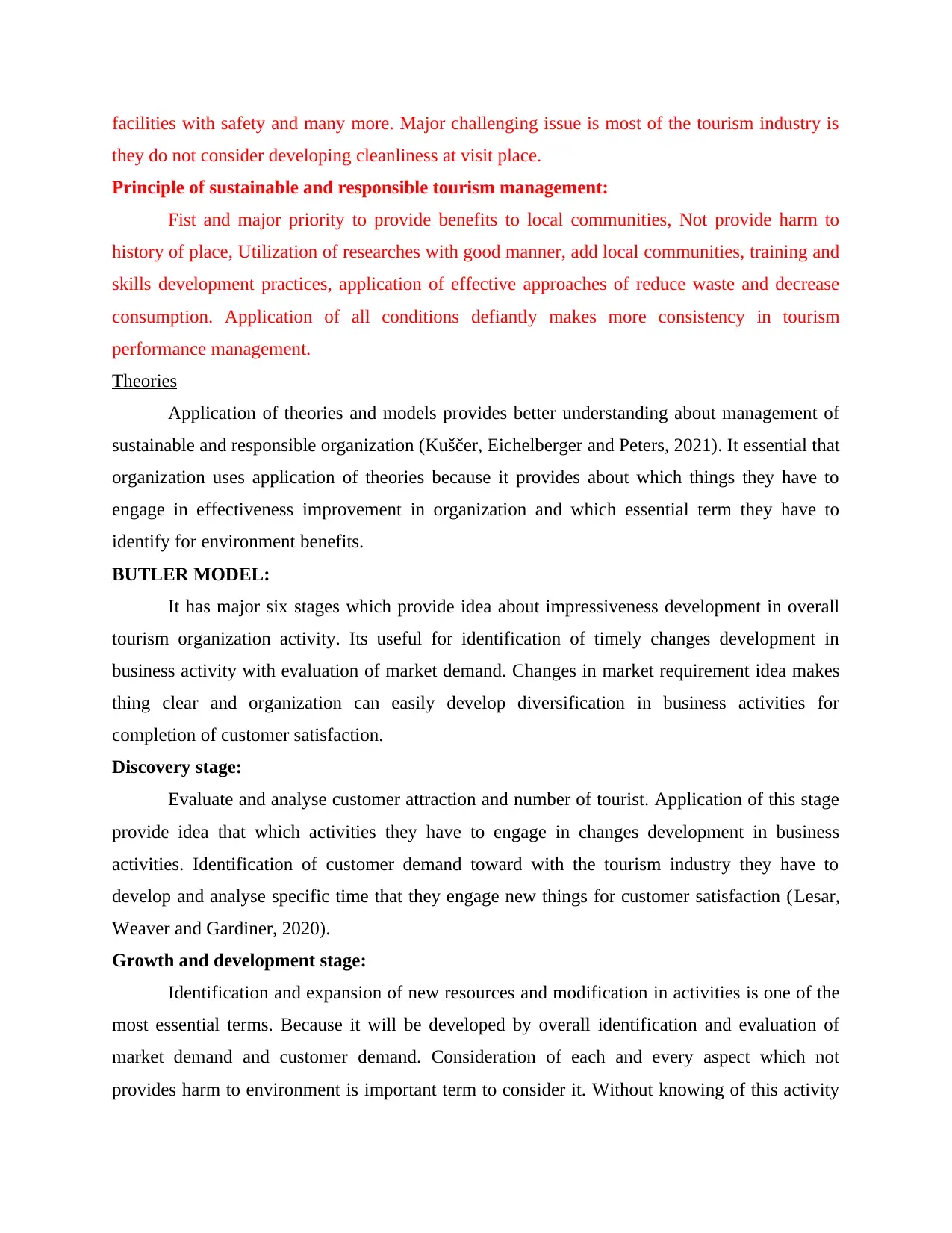
facilities with safety and many more. Major challenging issue is most of the tourism industry is
they do not consider developing cleanliness at visit place.
Principle of sustainable and responsible tourism management:
Fist and major priority to provide benefits to local communities, Not provide harm to
history of place, Utilization of researches with good manner, add local communities, training and
skills development practices, application of effective approaches of reduce waste and decrease
consumption. Application of all conditions defiantly makes more consistency in tourism
performance management.
Theories
Application of theories and models provides better understanding about management of
sustainable and responsible organization (Kuščer, Eichelberger and Peters, 2021). It essential that
organization uses application of theories because it provides about which things they have to
engage in effectiveness improvement in organization and which essential term they have to
identify for environment benefits.
BUTLER MODEL:
It has major six stages which provide idea about impressiveness development in overall
tourism organization activity. Its useful for identification of timely changes development in
business activity with evaluation of market demand. Changes in market requirement idea makes
thing clear and organization can easily develop diversification in business activities for
completion of customer satisfaction.
Discovery stage:
Evaluate and analyse customer attraction and number of tourist. Application of this stage
provide idea that which activities they have to engage in changes development in business
activities. Identification of customer demand toward with the tourism industry they have to
develop and analyse specific time that they engage new things for customer satisfaction (Lesar,
Weaver and Gardiner, 2020).
Growth and development stage:
Identification and expansion of new resources and modification in activities is one of the
most essential terms. Because it will be developed by overall identification and evaluation of
market demand and customer demand. Consideration of each and every aspect which not
provides harm to environment is important term to consider it. Without knowing of this activity
they do not consider developing cleanliness at visit place.
Principle of sustainable and responsible tourism management:
Fist and major priority to provide benefits to local communities, Not provide harm to
history of place, Utilization of researches with good manner, add local communities, training and
skills development practices, application of effective approaches of reduce waste and decrease
consumption. Application of all conditions defiantly makes more consistency in tourism
performance management.
Theories
Application of theories and models provides better understanding about management of
sustainable and responsible organization (Kuščer, Eichelberger and Peters, 2021). It essential that
organization uses application of theories because it provides about which things they have to
engage in effectiveness improvement in organization and which essential term they have to
identify for environment benefits.
BUTLER MODEL:
It has major six stages which provide idea about impressiveness development in overall
tourism organization activity. Its useful for identification of timely changes development in
business activity with evaluation of market demand. Changes in market requirement idea makes
thing clear and organization can easily develop diversification in business activities for
completion of customer satisfaction.
Discovery stage:
Evaluate and analyse customer attraction and number of tourist. Application of this stage
provide idea that which activities they have to engage in changes development in business
activities. Identification of customer demand toward with the tourism industry they have to
develop and analyse specific time that they engage new things for customer satisfaction (Lesar,
Weaver and Gardiner, 2020).
Growth and development stage:
Identification and expansion of new resources and modification in activities is one of the
most essential terms. Because it will be developed by overall identification and evaluation of
market demand and customer demand. Consideration of each and every aspect which not
provides harm to environment is important term to consider it. Without knowing of this activity
Paraphrase This Document
Need a fresh take? Get an instant paraphrase of this document with our AI Paraphraser
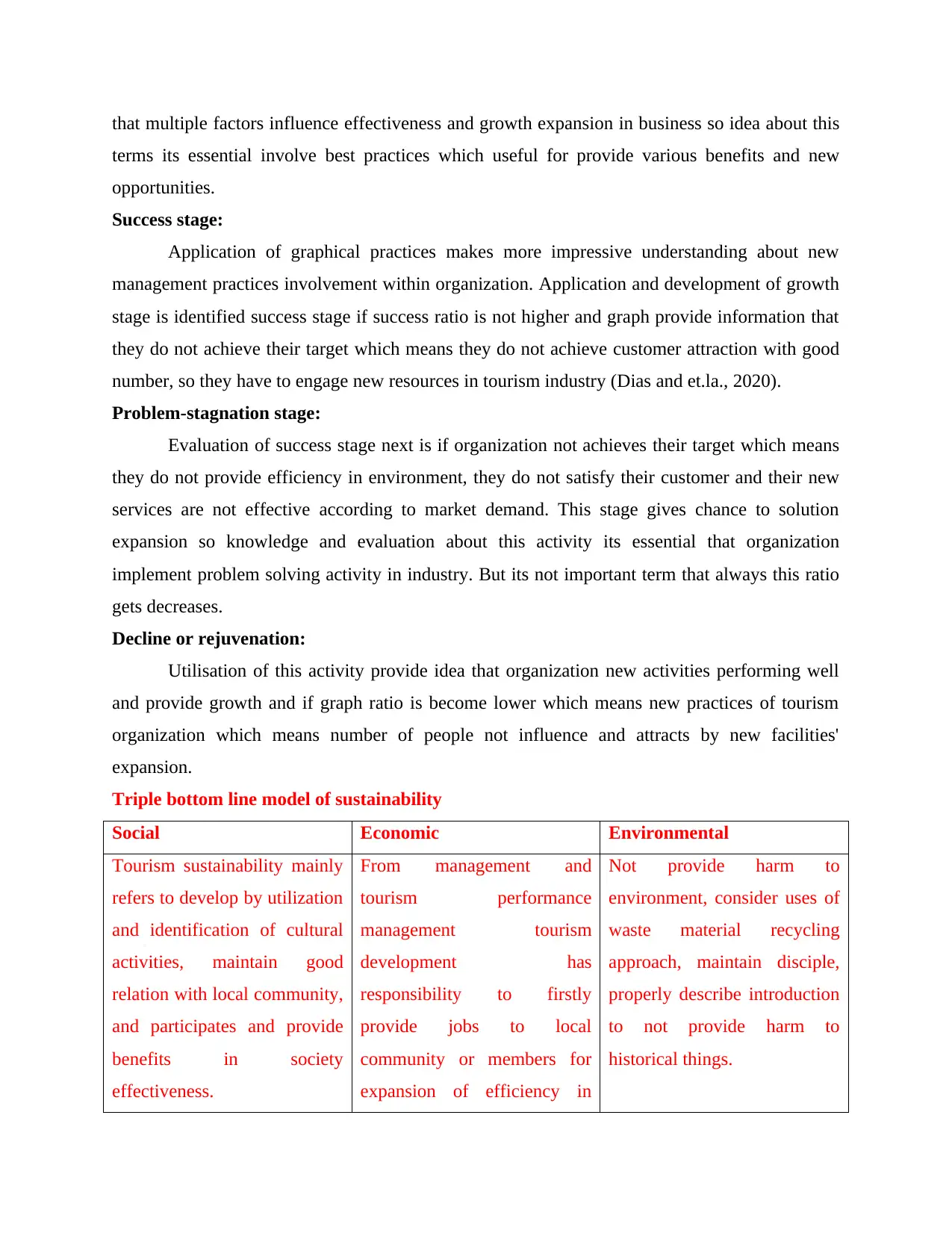
that multiple factors influence effectiveness and growth expansion in business so idea about this
terms its essential involve best practices which useful for provide various benefits and new
opportunities.
Success stage:
Application of graphical practices makes more impressive understanding about new
management practices involvement within organization. Application and development of growth
stage is identified success stage if success ratio is not higher and graph provide information that
they do not achieve their target which means they do not achieve customer attraction with good
number, so they have to engage new resources in tourism industry (Dias and et.la., 2020).
Problem-stagnation stage:
Evaluation of success stage next is if organization not achieves their target which means
they do not provide efficiency in environment, they do not satisfy their customer and their new
services are not effective according to market demand. This stage gives chance to solution
expansion so knowledge and evaluation about this activity its essential that organization
implement problem solving activity in industry. But its not important term that always this ratio
gets decreases.
Decline or rejuvenation:
Utilisation of this activity provide idea that organization new activities performing well
and provide growth and if graph ratio is become lower which means new practices of tourism
organization which means number of people not influence and attracts by new facilities'
expansion.
Triple bottom line model of sustainability
Social Economic Environmental
Tourism sustainability mainly
refers to develop by utilization
and identification of cultural
activities, maintain good
relation with local community,
and participates and provide
benefits in society
effectiveness.
From management and
tourism performance
management tourism
development has
responsibility to firstly
provide jobs to local
community or members for
expansion of efficiency in
Not provide harm to
environment, consider uses of
waste material recycling
approach, maintain disciple,
properly describe introduction
to not provide harm to
historical things.
terms its essential involve best practices which useful for provide various benefits and new
opportunities.
Success stage:
Application of graphical practices makes more impressive understanding about new
management practices involvement within organization. Application and development of growth
stage is identified success stage if success ratio is not higher and graph provide information that
they do not achieve their target which means they do not achieve customer attraction with good
number, so they have to engage new resources in tourism industry (Dias and et.la., 2020).
Problem-stagnation stage:
Evaluation of success stage next is if organization not achieves their target which means
they do not provide efficiency in environment, they do not satisfy their customer and their new
services are not effective according to market demand. This stage gives chance to solution
expansion so knowledge and evaluation about this activity its essential that organization
implement problem solving activity in industry. But its not important term that always this ratio
gets decreases.
Decline or rejuvenation:
Utilisation of this activity provide idea that organization new activities performing well
and provide growth and if graph ratio is become lower which means new practices of tourism
organization which means number of people not influence and attracts by new facilities'
expansion.
Triple bottom line model of sustainability
Social Economic Environmental
Tourism sustainability mainly
refers to develop by utilization
and identification of cultural
activities, maintain good
relation with local community,
and participates and provide
benefits in society
effectiveness.
From management and
tourism performance
management tourism
development has
responsibility to firstly
provide jobs to local
community or members for
expansion of efficiency in
Not provide harm to
environment, consider uses of
waste material recycling
approach, maintain disciple,
properly describe introduction
to not provide harm to
historical things.
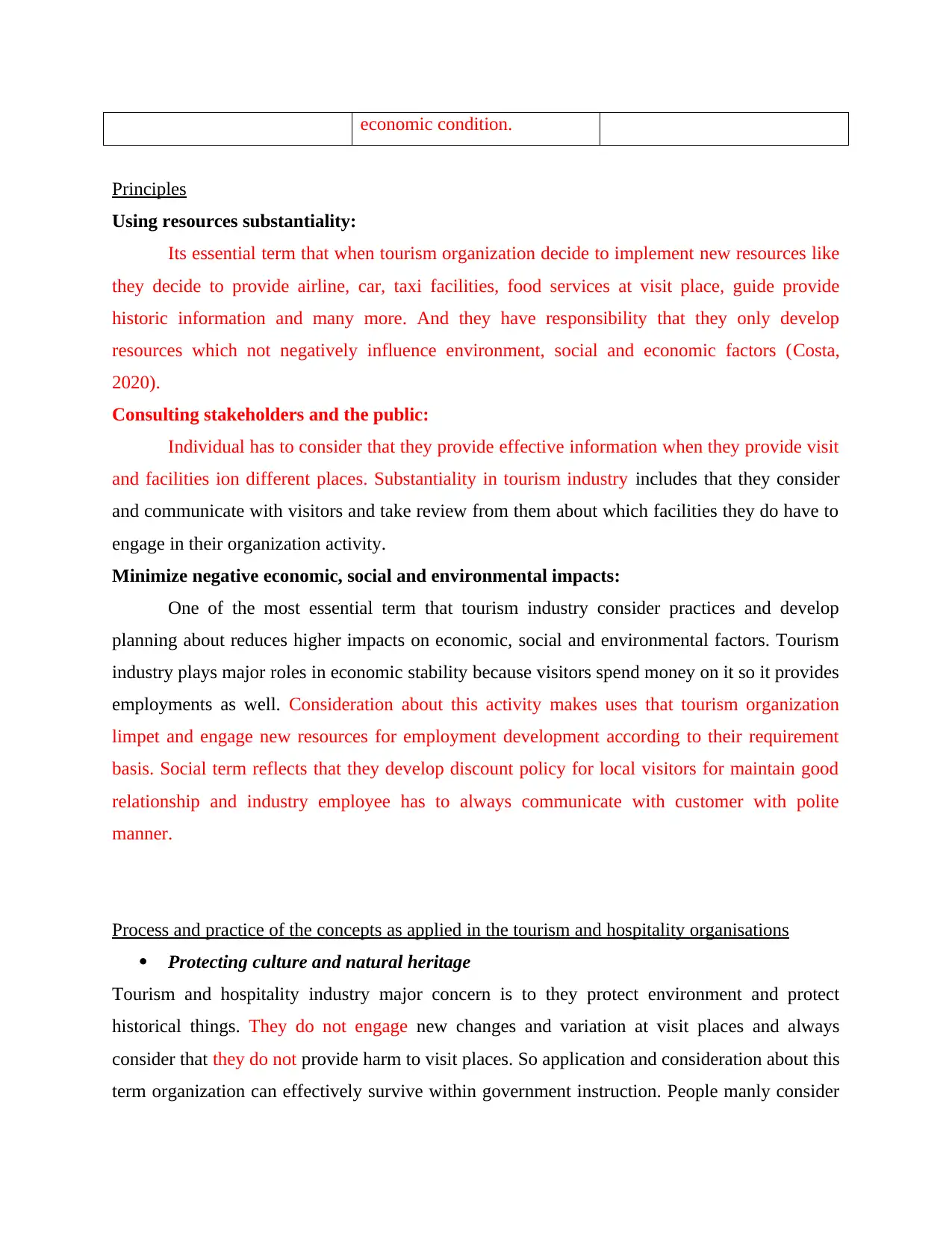
economic condition.
Principles
Using resources substantiality:
Its essential term that when tourism organization decide to implement new resources like
they decide to provide airline, car, taxi facilities, food services at visit place, guide provide
historic information and many more. And they have responsibility that they only develop
resources which not negatively influence environment, social and economic factors (Costa,
2020).
Consulting stakeholders and the public:
Individual has to consider that they provide effective information when they provide visit
and facilities ion different places. Substantiality in tourism industry includes that they consider
and communicate with visitors and take review from them about which facilities they do have to
engage in their organization activity.
Minimize negative economic, social and environmental impacts:
One of the most essential term that tourism industry consider practices and develop
planning about reduces higher impacts on economic, social and environmental factors. Tourism
industry plays major roles in economic stability because visitors spend money on it so it provides
employments as well. Consideration about this activity makes uses that tourism organization
limpet and engage new resources for employment development according to their requirement
basis. Social term reflects that they develop discount policy for local visitors for maintain good
relationship and industry employee has to always communicate with customer with polite
manner.
Process and practice of the concepts as applied in the tourism and hospitality organisations
Protecting culture and natural heritage
Tourism and hospitality industry major concern is to they protect environment and protect
historical things. They do not engage new changes and variation at visit places and always
consider that they do not provide harm to visit places. So application and consideration about this
term organization can effectively survive within government instruction. People manly consider
Principles
Using resources substantiality:
Its essential term that when tourism organization decide to implement new resources like
they decide to provide airline, car, taxi facilities, food services at visit place, guide provide
historic information and many more. And they have responsibility that they only develop
resources which not negatively influence environment, social and economic factors (Costa,
2020).
Consulting stakeholders and the public:
Individual has to consider that they provide effective information when they provide visit
and facilities ion different places. Substantiality in tourism industry includes that they consider
and communicate with visitors and take review from them about which facilities they do have to
engage in their organization activity.
Minimize negative economic, social and environmental impacts:
One of the most essential term that tourism industry consider practices and develop
planning about reduces higher impacts on economic, social and environmental factors. Tourism
industry plays major roles in economic stability because visitors spend money on it so it provides
employments as well. Consideration about this activity makes uses that tourism organization
limpet and engage new resources for employment development according to their requirement
basis. Social term reflects that they develop discount policy for local visitors for maintain good
relationship and industry employee has to always communicate with customer with polite
manner.
Process and practice of the concepts as applied in the tourism and hospitality organisations
Protecting culture and natural heritage
Tourism and hospitality industry major concern is to they protect environment and protect
historical things. They do not engage new changes and variation at visit places and always
consider that they do not provide harm to visit places. So application and consideration about this
term organization can effectively survive within government instruction. People manly consider
⊘ This is a preview!⊘
Do you want full access?
Subscribe today to unlock all pages.

Trusted by 1+ million students worldwide
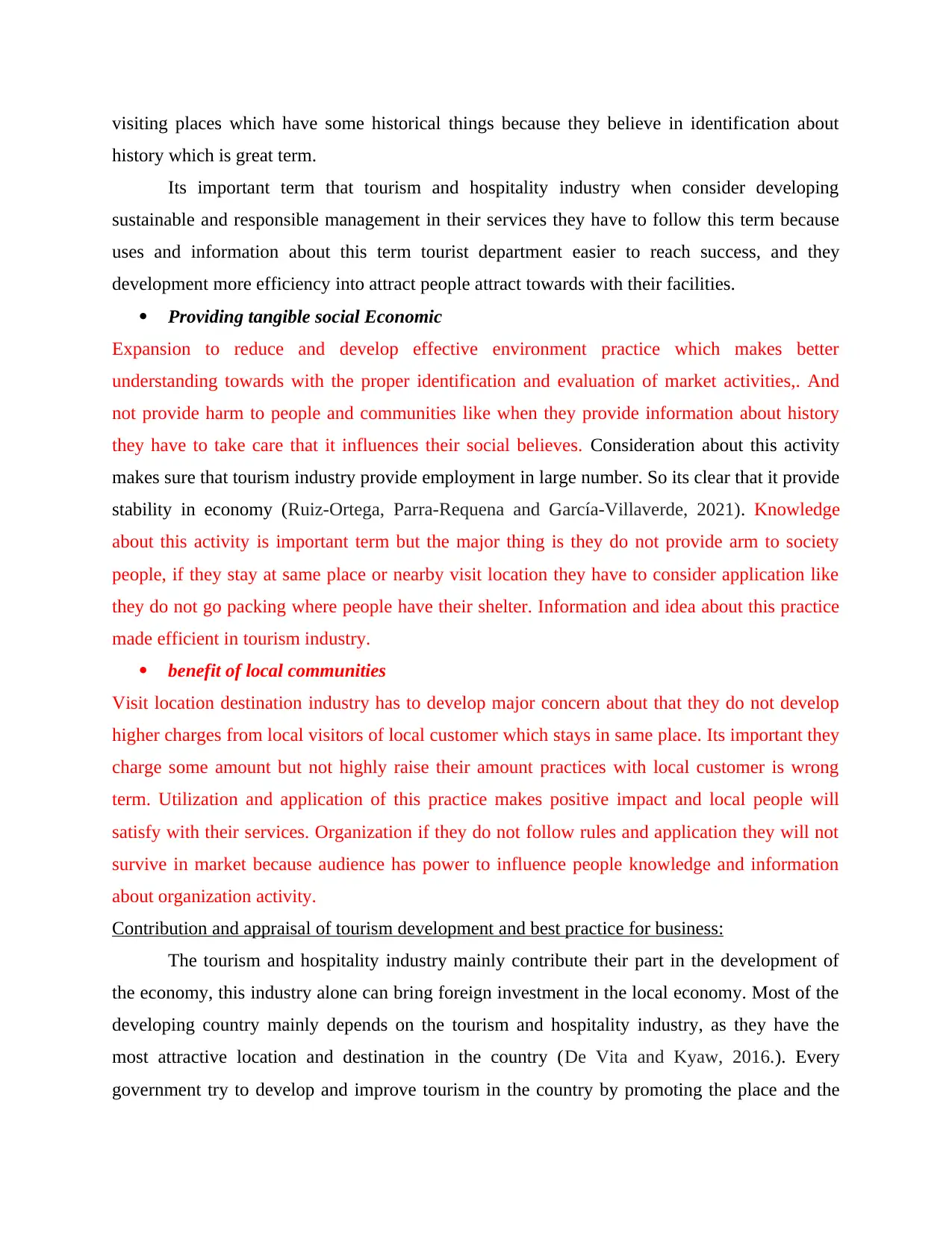
visiting places which have some historical things because they believe in identification about
history which is great term.
Its important term that tourism and hospitality industry when consider developing
sustainable and responsible management in their services they have to follow this term because
uses and information about this term tourist department easier to reach success, and they
development more efficiency into attract people attract towards with their facilities.
Providing tangible social Economic
Expansion to reduce and develop effective environment practice which makes better
understanding towards with the proper identification and evaluation of market activities,. And
not provide harm to people and communities like when they provide information about history
they have to take care that it influences their social believes. Consideration about this activity
makes sure that tourism industry provide employment in large number. So its clear that it provide
stability in economy (Ruiz-Ortega, Parra-Requena and García-Villaverde, 2021). Knowledge
about this activity is important term but the major thing is they do not provide arm to society
people, if they stay at same place or nearby visit location they have to consider application like
they do not go packing where people have their shelter. Information and idea about this practice
made efficient in tourism industry.
benefit of local communities
Visit location destination industry has to develop major concern about that they do not develop
higher charges from local visitors of local customer which stays in same place. Its important they
charge some amount but not highly raise their amount practices with local customer is wrong
term. Utilization and application of this practice makes positive impact and local people will
satisfy with their services. Organization if they do not follow rules and application they will not
survive in market because audience has power to influence people knowledge and information
about organization activity.
Contribution and appraisal of tourism development and best practice for business:
The tourism and hospitality industry mainly contribute their part in the development of
the economy, this industry alone can bring foreign investment in the local economy. Most of the
developing country mainly depends on the tourism and hospitality industry, as they have the
most attractive location and destination in the country (De Vita and Kyaw, 2016.). Every
government try to develop and improve tourism in the country by promoting the place and the
history which is great term.
Its important term that tourism and hospitality industry when consider developing
sustainable and responsible management in their services they have to follow this term because
uses and information about this term tourist department easier to reach success, and they
development more efficiency into attract people attract towards with their facilities.
Providing tangible social Economic
Expansion to reduce and develop effective environment practice which makes better
understanding towards with the proper identification and evaluation of market activities,. And
not provide harm to people and communities like when they provide information about history
they have to take care that it influences their social believes. Consideration about this activity
makes sure that tourism industry provide employment in large number. So its clear that it provide
stability in economy (Ruiz-Ortega, Parra-Requena and García-Villaverde, 2021). Knowledge
about this activity is important term but the major thing is they do not provide arm to society
people, if they stay at same place or nearby visit location they have to consider application like
they do not go packing where people have their shelter. Information and idea about this practice
made efficient in tourism industry.
benefit of local communities
Visit location destination industry has to develop major concern about that they do not develop
higher charges from local visitors of local customer which stays in same place. Its important they
charge some amount but not highly raise their amount practices with local customer is wrong
term. Utilization and application of this practice makes positive impact and local people will
satisfy with their services. Organization if they do not follow rules and application they will not
survive in market because audience has power to influence people knowledge and information
about organization activity.
Contribution and appraisal of tourism development and best practice for business:
The tourism and hospitality industry mainly contribute their part in the development of
the economy, this industry alone can bring foreign investment in the local economy. Most of the
developing country mainly depends on the tourism and hospitality industry, as they have the
most attractive location and destination in the country (De Vita and Kyaw, 2016.). Every
government try to develop and improve tourism in the country by promoting the place and the
Paraphrase This Document
Need a fresh take? Get an instant paraphrase of this document with our AI Paraphraser
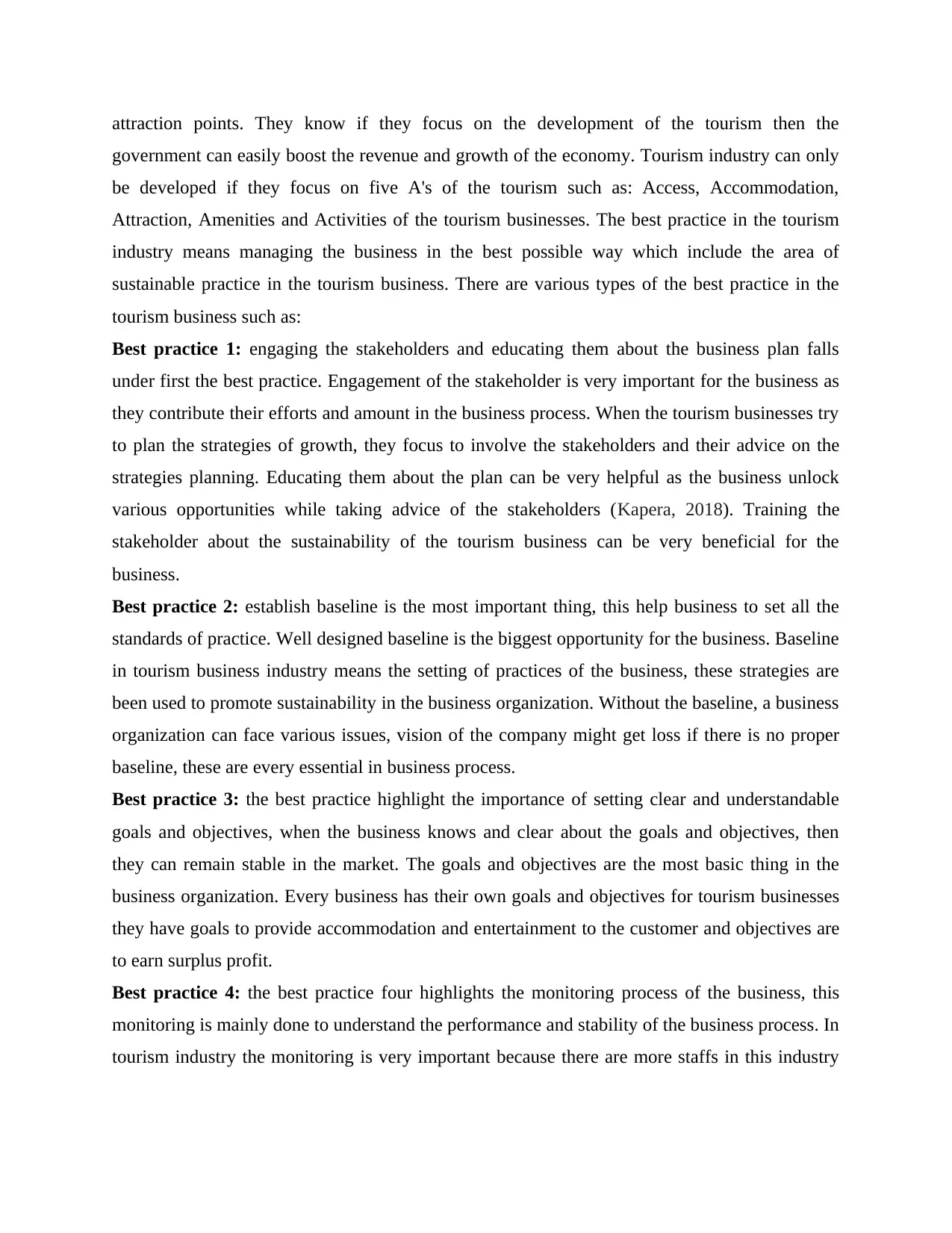
attraction points. They know if they focus on the development of the tourism then the
government can easily boost the revenue and growth of the economy. Tourism industry can only
be developed if they focus on five A's of the tourism such as: Access, Accommodation,
Attraction, Amenities and Activities of the tourism businesses. The best practice in the tourism
industry means managing the business in the best possible way which include the area of
sustainable practice in the tourism business. There are various types of the best practice in the
tourism business such as:
Best practice 1: engaging the stakeholders and educating them about the business plan falls
under first the best practice. Engagement of the stakeholder is very important for the business as
they contribute their efforts and amount in the business process. When the tourism businesses try
to plan the strategies of growth, they focus to involve the stakeholders and their advice on the
strategies planning. Educating them about the plan can be very helpful as the business unlock
various opportunities while taking advice of the stakeholders (Kapera, 2018). Training the
stakeholder about the sustainability of the tourism business can be very beneficial for the
business.
Best practice 2: establish baseline is the most important thing, this help business to set all the
standards of practice. Well designed baseline is the biggest opportunity for the business. Baseline
in tourism business industry means the setting of practices of the business, these strategies are
been used to promote sustainability in the business organization. Without the baseline, a business
organization can face various issues, vision of the company might get loss if there is no proper
baseline, these are every essential in business process.
Best practice 3: the best practice highlight the importance of setting clear and understandable
goals and objectives, when the business knows and clear about the goals and objectives, then
they can remain stable in the market. The goals and objectives are the most basic thing in the
business organization. Every business has their own goals and objectives for tourism businesses
they have goals to provide accommodation and entertainment to the customer and objectives are
to earn surplus profit.
Best practice 4: the best practice four highlights the monitoring process of the business, this
monitoring is mainly done to understand the performance and stability of the business process. In
tourism industry the monitoring is very important because there are more staffs in this industry
government can easily boost the revenue and growth of the economy. Tourism industry can only
be developed if they focus on five A's of the tourism such as: Access, Accommodation,
Attraction, Amenities and Activities of the tourism businesses. The best practice in the tourism
industry means managing the business in the best possible way which include the area of
sustainable practice in the tourism business. There are various types of the best practice in the
tourism business such as:
Best practice 1: engaging the stakeholders and educating them about the business plan falls
under first the best practice. Engagement of the stakeholder is very important for the business as
they contribute their efforts and amount in the business process. When the tourism businesses try
to plan the strategies of growth, they focus to involve the stakeholders and their advice on the
strategies planning. Educating them about the plan can be very helpful as the business unlock
various opportunities while taking advice of the stakeholders (Kapera, 2018). Training the
stakeholder about the sustainability of the tourism business can be very beneficial for the
business.
Best practice 2: establish baseline is the most important thing, this help business to set all the
standards of practice. Well designed baseline is the biggest opportunity for the business. Baseline
in tourism business industry means the setting of practices of the business, these strategies are
been used to promote sustainability in the business organization. Without the baseline, a business
organization can face various issues, vision of the company might get loss if there is no proper
baseline, these are every essential in business process.
Best practice 3: the best practice highlight the importance of setting clear and understandable
goals and objectives, when the business knows and clear about the goals and objectives, then
they can remain stable in the market. The goals and objectives are the most basic thing in the
business organization. Every business has their own goals and objectives for tourism businesses
they have goals to provide accommodation and entertainment to the customer and objectives are
to earn surplus profit.
Best practice 4: the best practice four highlights the monitoring process of the business, this
monitoring is mainly done to understand the performance and stability of the business process. In
tourism industry the monitoring is very important because there are more staffs in this industry

and to monitor them will be difficult. Tourism business needs to monitor the data provided by
the government as this can help to analyse the future events in the tourism industry.
the government as this can help to analyse the future events in the tourism industry.
⊘ This is a preview!⊘
Do you want full access?
Subscribe today to unlock all pages.

Trusted by 1+ million students worldwide
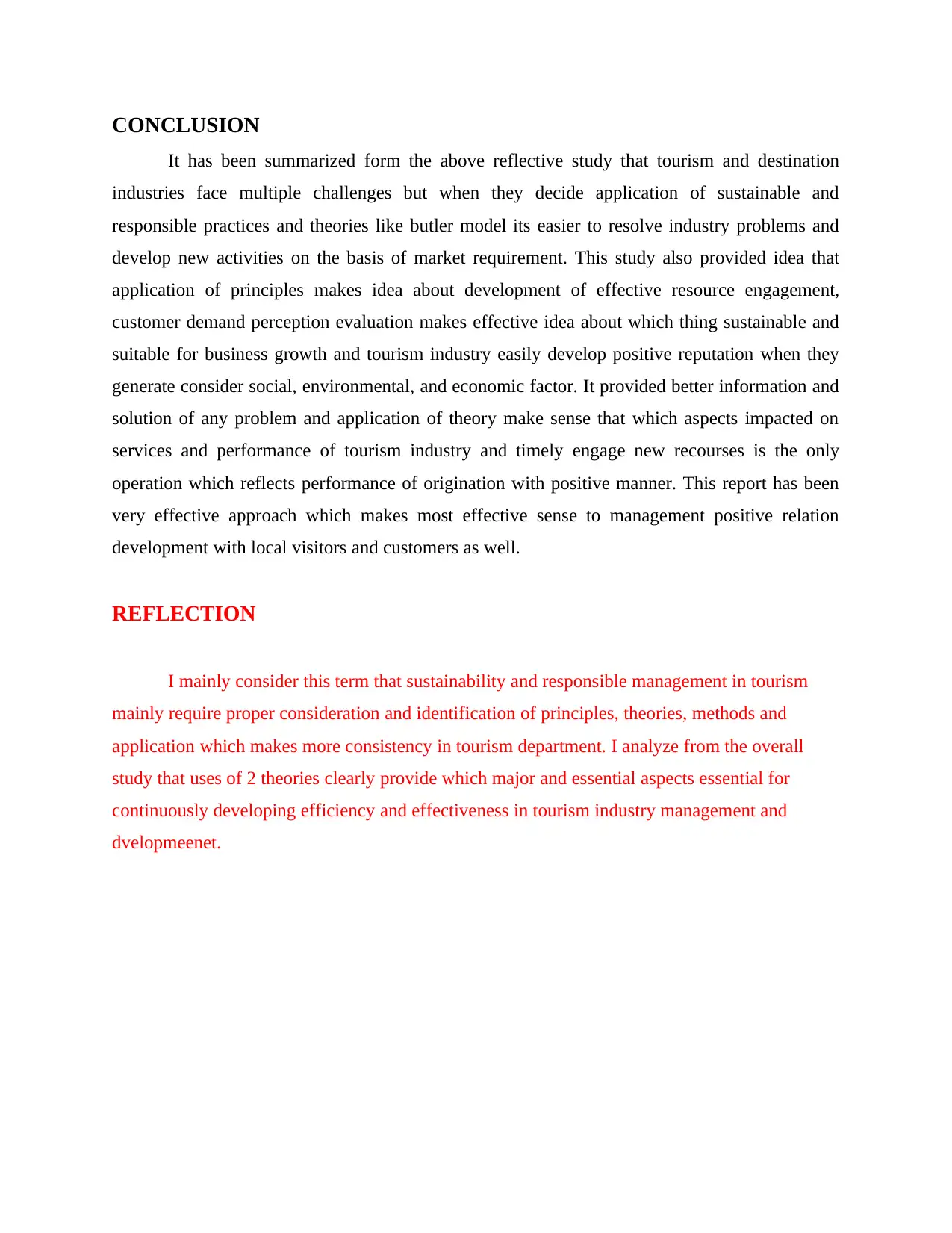
CONCLUSION
It has been summarized form the above reflective study that tourism and destination
industries face multiple challenges but when they decide application of sustainable and
responsible practices and theories like butler model its easier to resolve industry problems and
develop new activities on the basis of market requirement. This study also provided idea that
application of principles makes idea about development of effective resource engagement,
customer demand perception evaluation makes effective idea about which thing sustainable and
suitable for business growth and tourism industry easily develop positive reputation when they
generate consider social, environmental, and economic factor. It provided better information and
solution of any problem and application of theory make sense that which aspects impacted on
services and performance of tourism industry and timely engage new recourses is the only
operation which reflects performance of origination with positive manner. This report has been
very effective approach which makes most effective sense to management positive relation
development with local visitors and customers as well.
REFLECTION
I mainly consider this term that sustainability and responsible management in tourism
mainly require proper consideration and identification of principles, theories, methods and
application which makes more consistency in tourism department. I analyze from the overall
study that uses of 2 theories clearly provide which major and essential aspects essential for
continuously developing efficiency and effectiveness in tourism industry management and
dvelopmeenet.
It has been summarized form the above reflective study that tourism and destination
industries face multiple challenges but when they decide application of sustainable and
responsible practices and theories like butler model its easier to resolve industry problems and
develop new activities on the basis of market requirement. This study also provided idea that
application of principles makes idea about development of effective resource engagement,
customer demand perception evaluation makes effective idea about which thing sustainable and
suitable for business growth and tourism industry easily develop positive reputation when they
generate consider social, environmental, and economic factor. It provided better information and
solution of any problem and application of theory make sense that which aspects impacted on
services and performance of tourism industry and timely engage new recourses is the only
operation which reflects performance of origination with positive manner. This report has been
very effective approach which makes most effective sense to management positive relation
development with local visitors and customers as well.
REFLECTION
I mainly consider this term that sustainability and responsible management in tourism
mainly require proper consideration and identification of principles, theories, methods and
application which makes more consistency in tourism department. I analyze from the overall
study that uses of 2 theories clearly provide which major and essential aspects essential for
continuously developing efficiency and effectiveness in tourism industry management and
dvelopmeenet.
Paraphrase This Document
Need a fresh take? Get an instant paraphrase of this document with our AI Paraphraser
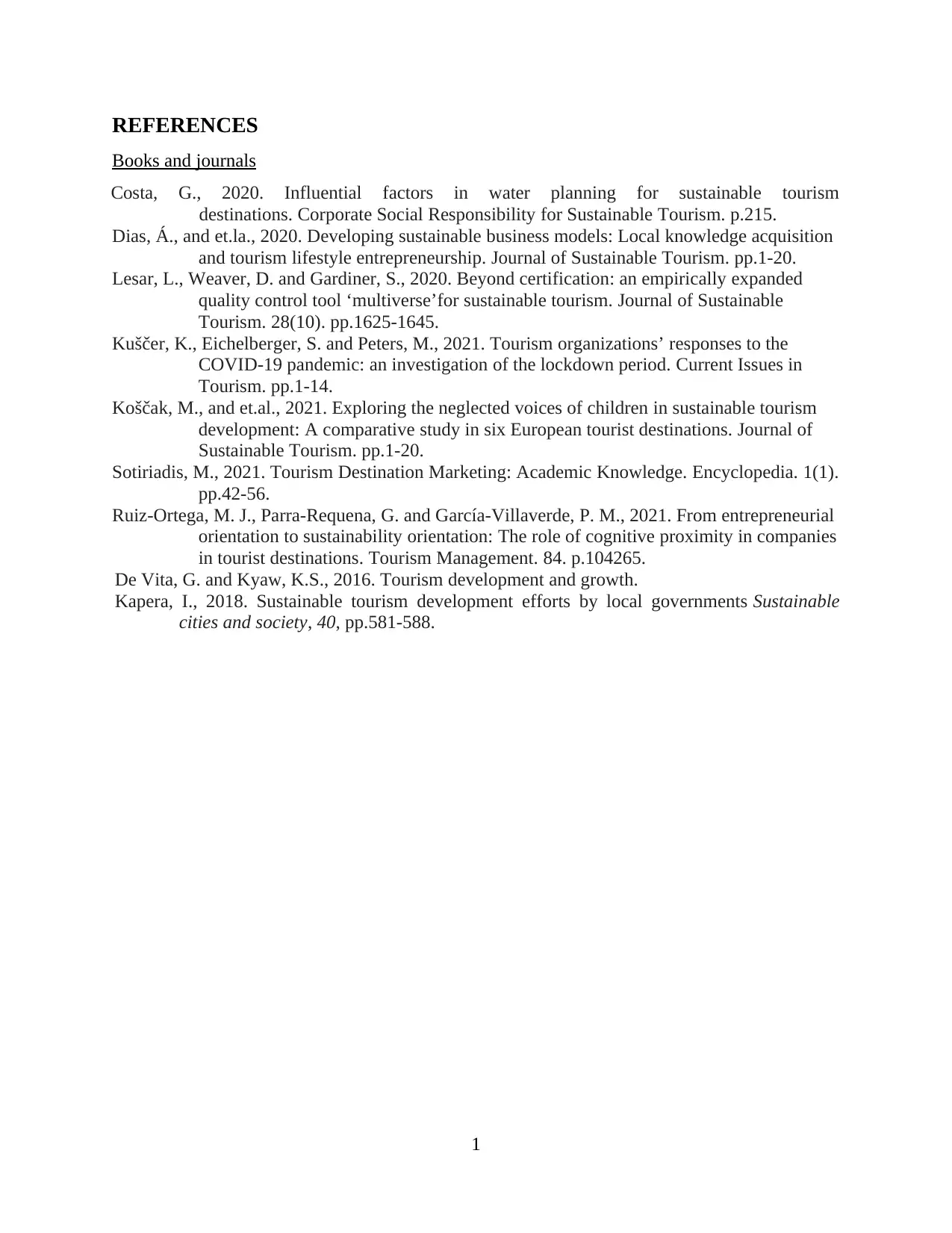
REFERENCES
Books and journals
Costa, G., 2020. Influential factors in water planning for sustainable tourism
destinations. Corporate Social Responsibility for Sustainable Tourism. p.215.
Dias, Á., and et.la., 2020. Developing sustainable business models: Local knowledge acquisition
and tourism lifestyle entrepreneurship. Journal of Sustainable Tourism. pp.1-20.
Lesar, L., Weaver, D. and Gardiner, S., 2020. Beyond certification: an empirically expanded
quality control tool ‘multiverse’for sustainable tourism. Journal of Sustainable
Tourism. 28(10). pp.1625-1645.
Kuščer, K., Eichelberger, S. and Peters, M., 2021. Tourism organizations’ responses to the
COVID-19 pandemic: an investigation of the lockdown period. Current Issues in
Tourism. pp.1-14.
Koščak, M., and et.al., 2021. Exploring the neglected voices of children in sustainable tourism
development: A comparative study in six European tourist destinations. Journal of
Sustainable Tourism. pp.1-20.
Sotiriadis, M., 2021. Tourism Destination Marketing: Academic Knowledge. Encyclopedia. 1(1).
pp.42-56.
Ruiz-Ortega, M. J., Parra-Requena, G. and García-Villaverde, P. M., 2021. From entrepreneurial
orientation to sustainability orientation: The role of cognitive proximity in companies
in tourist destinations. Tourism Management. 84. p.104265.
De Vita, G. and Kyaw, K.S., 2016. Tourism development and growth.
Kapera, I., 2018. Sustainable tourism development efforts by local governments Sustainable
cities and society, 40, pp.581-588.
1
Books and journals
Costa, G., 2020. Influential factors in water planning for sustainable tourism
destinations. Corporate Social Responsibility for Sustainable Tourism. p.215.
Dias, Á., and et.la., 2020. Developing sustainable business models: Local knowledge acquisition
and tourism lifestyle entrepreneurship. Journal of Sustainable Tourism. pp.1-20.
Lesar, L., Weaver, D. and Gardiner, S., 2020. Beyond certification: an empirically expanded
quality control tool ‘multiverse’for sustainable tourism. Journal of Sustainable
Tourism. 28(10). pp.1625-1645.
Kuščer, K., Eichelberger, S. and Peters, M., 2021. Tourism organizations’ responses to the
COVID-19 pandemic: an investigation of the lockdown period. Current Issues in
Tourism. pp.1-14.
Koščak, M., and et.al., 2021. Exploring the neglected voices of children in sustainable tourism
development: A comparative study in six European tourist destinations. Journal of
Sustainable Tourism. pp.1-20.
Sotiriadis, M., 2021. Tourism Destination Marketing: Academic Knowledge. Encyclopedia. 1(1).
pp.42-56.
Ruiz-Ortega, M. J., Parra-Requena, G. and García-Villaverde, P. M., 2021. From entrepreneurial
orientation to sustainability orientation: The role of cognitive proximity in companies
in tourist destinations. Tourism Management. 84. p.104265.
De Vita, G. and Kyaw, K.S., 2016. Tourism development and growth.
Kapera, I., 2018. Sustainable tourism development efforts by local governments Sustainable
cities and society, 40, pp.581-588.
1
1 out of 11
Related Documents
Your All-in-One AI-Powered Toolkit for Academic Success.
+13062052269
info@desklib.com
Available 24*7 on WhatsApp / Email
![[object Object]](/_next/static/media/star-bottom.7253800d.svg)
Unlock your academic potential
Copyright © 2020–2025 A2Z Services. All Rights Reserved. Developed and managed by ZUCOL.

